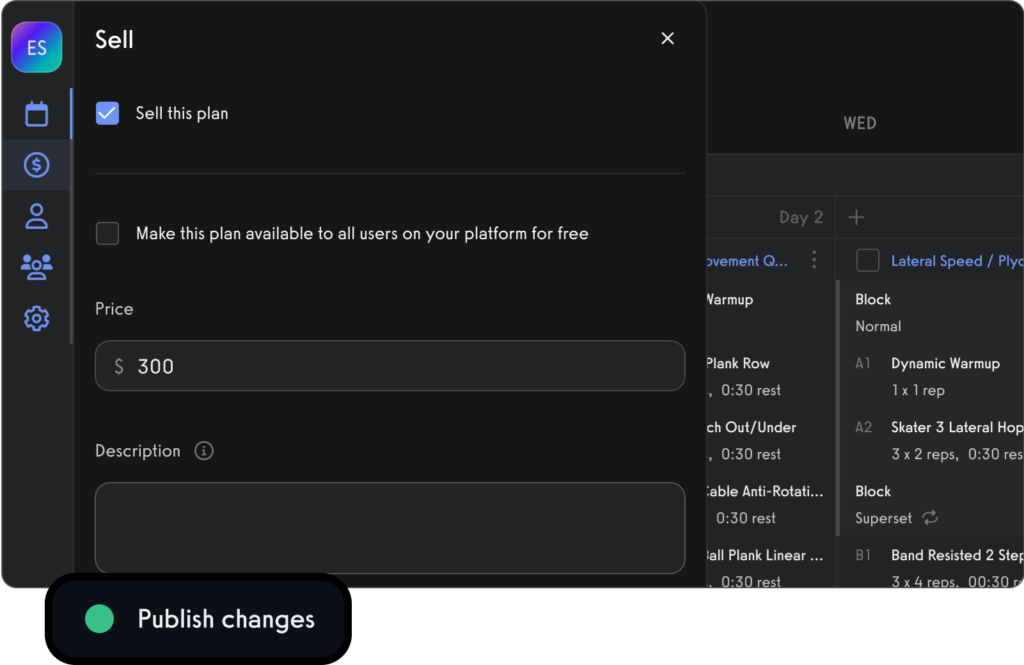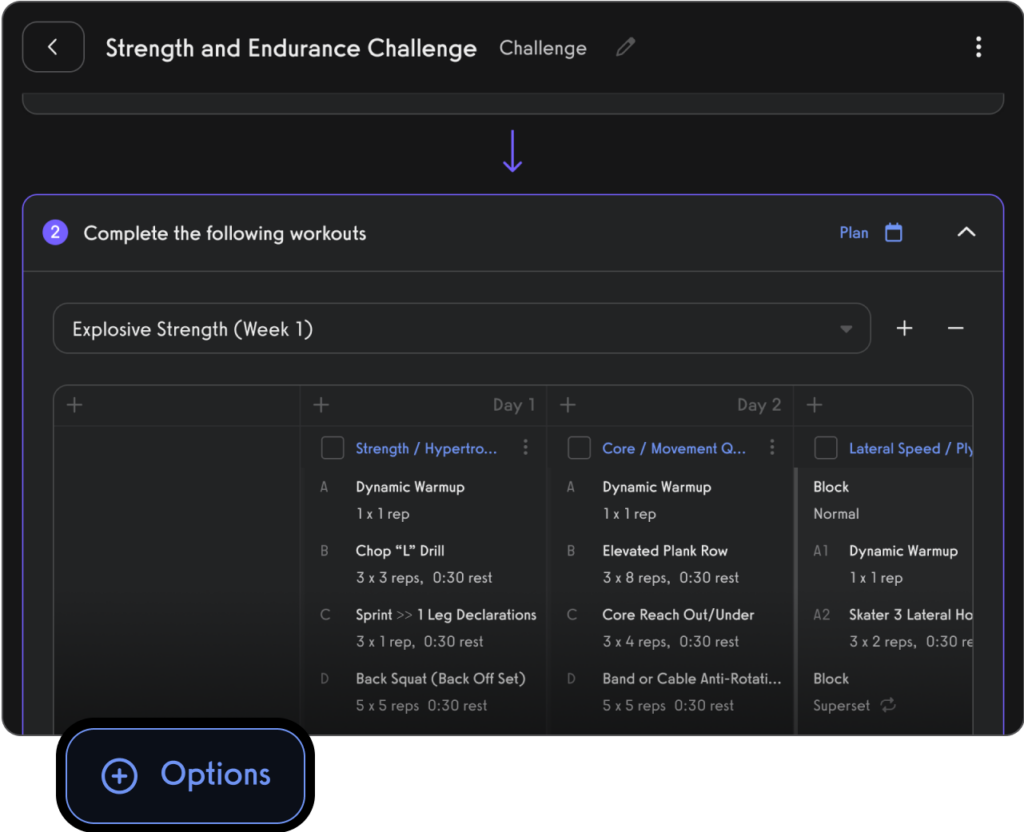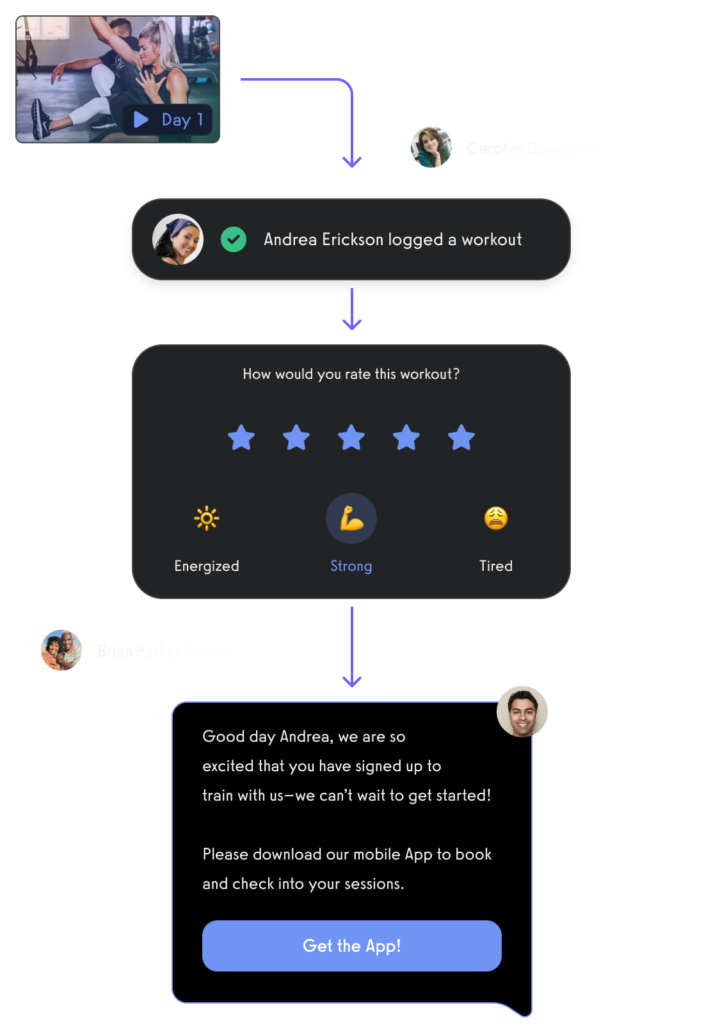Personal Trainer Business Plan Template (FREE)
Get this free personal trainer business plan template to learn how to create a personal trainer business plan. Use the free personal trainer business plan examples and then modify as needed.

Scroll down for a free personal training business plan template, and then be sure to check out our guide on how to create a gym business plan and then utilize the gym business plan template and fitness business plan template to get inspiration for creating your PT business plan.
Remember though, the important part is to get certified and then get started. Don’t delay, what you can start today. Learn how to start a fitness business, and how to start a personal training business, but don’t forget that you technically don’t have to be certified to sell workouts (though you should get certified!) so there are many ways to make money from fitness, one of which is making money selling workout plans online.

Then be sure to find the tools you need to grow a fitness influencer business. From the best software for gym management to the best software for personal training to the best fitness software for fitness influencers, the Exercise.com platform has the tools you need to grow and manage your fitness business.

Run online fitness challenges.

Create and sell fitness memberships, products, and digital offers.

Manage, message, and market to your leads and customers.

All from your very own custom branded fitness apps.


Personal Trainer Business Plan Template
Creating a business plan is a crucial step for personal trainers aspiring to establish a successful fitness business. A well-crafted business plan serves as a roadmap, outlining your goals, strategies, and the steps you need to take to achieve them. It provides clarity on your business model, target market, services offered, marketing and sales strategies, and financial planning. This plan is not only vital for your own reference and guidance but also essential if you’re seeking funding or partnerships.
A comprehensive business plan for a personal trainer should encompass several key components, including an executive summary, market analysis, business structure, services offered, marketing and sales strategies, and financial planning. Below is a detailed template that personal trainers can use as a guide to creating their own business plan.
Executive Summary
- Business Name and Location: Your business name and the location where you will operate.
- Mission Statement: A brief statement outlining your business’s purpose and goals.
- Business Goals: Short-term and long-term objectives for your personal training business.
- Owner’s Background: Your qualifications, experience, and any unique skills that set you apart.
Market Analysis
- Industry Overview: Current state and future outlook of the fitness industry.
- Target Market: Specific demographic and psychographic details of your ideal clients.
- Competitor Analysis: Overview of competitors, their offerings, strengths, and weaknesses.
- Market Trends: Emerging trends in personal training and fitness.
Business Structure
- Type of Business Entity: Whether you are a sole proprietor, partnership, LLC, etc.
- Business Model: How you plan to charge for your services (e.g., hourly rates, package deals).
- Facility and Equipment: Details about your training facility and equipment needs.
Services Offered
- Training Services: Types of personal training services you will offer (one-on-one, group sessions, online coaching).
- Special Programs: Any specialized programs or niche training services (e.g., weight loss, athletic training, rehabilitation).
- Additional Services: Other services like nutrition counseling, fitness assessments, etc.
Marketing and Sales Strategies
- Branding: Your business’s branding strategy, including logo, colors, and overall image.
- Marketing Channels: How you plan to market your services (social media, local advertising, partnerships).
- Sales Techniques: Strategies for selling your services and converting prospects into clients.
- Client Retention Strategies: Methods for retaining clients and encouraging long-term commitments.
Financial Planning
- Startup Costs: Initial costs involved in setting up your personal training business.
- Pricing Strategy: How you will price your services.
- Revenue Projections: Estimated earnings for the first few years.
- Expense Forecast: Ongoing operational costs (rent, equipment maintenance, marketing costs).
- Break-Even Analysis: The point at which your business will start to make a profit.
Additional Components
- Legal and Insurance Considerations: Necessary permits, licenses, and insurance policies.
- Risk Analysis: Potential risks your business may face and how you plan to mitigate them.
- Growth and Expansion Plans: How you plan to grow and scale your business in the future.
This template provides a comprehensive framework for a personal trainer business plan. Tailoring each section to reflect your unique vision, goals, and strategies will result in a robust and effective business plan, guiding your venture towards success.
Read More:
- Personal Trainer Marketing
- Personal Trainer Mission Statements
- Personal Trainer Insurance
- Best Personal Trainer Software
#1 Example Mobile Personal Training Business Plan
Summary
“Fit On The Go” is a mobile personal training business catering to busy professionals and parents who struggle to find time for gym visits. Our mission is to bring customized fitness solutions directly to clients, offering convenience, flexibility, and personalized attention. We aim to tap into the local market of working professionals in urban areas, delivering tailored workout sessions at their homes, offices, or outdoor spaces.
Business Structure
- Type: Sole Proprietorship
- Business Model: Charging clients on a session-by-session basis or through monthly packages.
- Facility and Equipment: No fixed facility; equipment is portable and suitable for various environments.
Services Offered
- Training Services: One-on-one and small group training sessions, including strength training, cardio, and flexibility workouts.
- Special Programs: Corporate wellness programs, post-natal fitness, senior fitness.
- Additional Services: Basic nutritional advice and online support.
Market Analysis
- Industry Overview: Growing demand for personalized and convenient fitness options.
- Target Market: Busy professionals aged 30-50, new parents, and corporations.
- Competitor Analysis: Other local personal trainers and fitness apps.
- Market Trends: Increasing interest in health and well-being, especially post-pandemic.
Marketing and Sales Strategies
- Branding: Professional, approachable, and tailored to busy lifestyles.
- Marketing Channels: Social media marketing, local networking events, partnerships with local businesses.
- Sales Techniques: Free first sessions, referral incentives.
- Client Retention Strategies: Personalized progress tracking, flexible scheduling.
Financial Planning
- Startup Costs: Minimal – mainly for equipment and marketing.
- Pricing Strategy: Competitive pricing with discounts for package purchases.
- Revenue Projections: Aim to achieve a steady client base within the first year.
- Expense Forecast: Ongoing costs including travel expenses, equipment maintenance, and marketing.
- Break-Even Analysis: Expected within the first six months.
Read More: Mobile Fitness Business Guide
#2 Example Boutique Personal Training Studio Business Plan
Summary
“Elite Fitness Studio” is a boutique personal training studio located in a high-end neighborhood, focusing on providing exclusive, high-quality fitness experiences. Our goal is to create a community of fitness enthusiasts who value personalized attention, state-of-the-art facilities, and a supportive environment.
Business Structure
- Type: Limited Liability Company (LLC)
- Business Model: Membership-based with additional charges for personal training sessions.
- Facility and Equipment: Well-equipped studio with modern fitness equipment.
Services Offered
- Training Services: Individual and small group personal training, specializing in weight loss, muscle building, and athletic performance.
- Special Programs: Wellness retreats, fitness workshops, and seminars.
- Additional Services: In-house nutritionist consultations, physiotherapy services.
Market Analysis
- Industry Overview: Increasing demand for exclusive and specialized fitness services.
- Target Market: Affluent individuals aged 25-55, athletes, and fitness enthusiasts.
- Competitor Analysis: Other high-end fitness studios and luxury gyms.
- Market Trends: Personalization in fitness and holistic health approaches.
Marketing and Sales Strategies
- Branding: Luxurious, exclusive, and results-driven.
- Marketing Channels: High-end local magazines, community events, influencer partnerships.
- Sales Techniques: Membership exclusivity, premium pricing.
- Client Retention Strategies: Customized fitness plans, member-only events, loyalty rewards.
Financial Planning
- Startup Costs: Significant – for studio setup, equipment, and initial marketing.
- Pricing Strategy: Premium pricing reflecting the exclusivity and quality of services.
- Revenue Projections: Gradual growth with an expansion of services and client base.
- Expense Forecast: High, including rent, equipment maintenance, staff salaries, and marketing.
- Break-Even Analysis: Expected within the first 18 months.
Read More: Best Boutique Fitness Studio Software
#3 Example Online Personal Training Business Plan
Summary
“Virtual Fitness Coach” is an online personal training business providing remote fitness coaching and virtual workout sessions. We focus on offering convenient, accessible, and customized fitness solutions to individuals globally, utilizing technology to bridge geographical gaps.
Business Structure
- Type: Partnership
- Business Model: Subscription-based online services with various tiered plans.
- Facility and Equipment: Home office setup with necessary tech equipment for virtual sessions.
Services Offered
- Training Services: Live virtual training sessions, pre-recorded workout programs.
- Special Programs: Weight loss challenges, fitness boot camps, yoga and mindfulness sessions.
- Additional Services: Online nutrition coaching, fitness blogs, and webinars.
Market Analysis
- Industry Overview: Surge in demand for online fitness services.
- Target Market: Tech-savvy individuals, those with limited access to gyms, global clientele.
- Competitor Analysis: Other online fitness platforms and apps.
- Market Trends: Digital transformation in fitness, growing popularity of home workouts.
Marketing and Sales Strategies
- Branding: Modern, accessible, and tech-friendly.
- Marketing Channels: Social media advertising, content marketing, online fitness communities.
- Sales Techniques: Free trials, tiered pricing plans.
- Client Retention Strategies: Engaging online community, regular program updates, personalized feedback.
Financial Planning
- Startup Costs: Moderate – mainly for software, website development, and initial marketing.
- Pricing Strategy: Subscription-based with different tiers for various needs.
- Revenue Projections: Aim for global reach and a substantial subscriber base within the first year.
- Expense Forecast: Moderate, including website maintenance, marketing, and software subscriptions.
- Break-Even Analysis: Projected within the first 12 months.
Each of these fitness trainer business plans caters to different market segments and operational models, offering a diverse range of services and experiences. Personal trainers can adapt these templates to align with their specific goals, target audience, and available resources.
Read More: Best Online Fitness Coach Software

The Importance of Having a Business Plan as a Personal Trainer
Welcome to our comprehensive guide on creating a successful personal trainer business plan. In this article, we will explore the importance of having a business plan as a personal trainer, delve into the key elements to include in your plan, and provide detailed insights into various aspects of running a thriving personal training business.
Looking to start your own personal training business? This comprehensive personal training business plan template will guide you through the process, helping you outline your goals, target market, marketing strategies, financial projections, and more.
As a personal trainer, having a well-defined business plan is crucial to your success. It serves as a roadmap that outlines your goals, strategies, and tactics for achieving them. A solid business plan helps you stay focused, organized, and accountable. It allows you to clearly articulate your mission, vision, and unique value proposition to potential clients, partners, and investors.
Furthermore, a business plan helps you foresee challenges and identify opportunities in the ever-evolving fitness industry. It allows you to devise strategies to effectively navigate market fluctuations, competition, and changing consumer preferences. Ultimately, a well-crafted business plan sets the foundation for your personal training business and increases your chances of long-term success.
One key benefit of having a business plan as a personal trainer is that it helps you establish a clear financial strategy. By outlining your revenue streams, expenses, and pricing structure, you can ensure that your personal training business remains profitable. Additionally, a business plan allows you to set financial goals and track your progress towards achieving them, providing you with a benchmark for success.
Another advantage of having a business plan is that it enables you to effectively market and promote your personal training services. With a well-defined target market and a comprehensive marketing strategy, you can identify the most effective channels to reach potential clients. Your business plan can also include a detailed analysis of your competition, allowing you to differentiate yourself and highlight your unique selling points.
Key Elements to Include in Your Personal Trainer Business Plan
A comprehensive personal trainer business plan should consist of several key elements. These include:
1. Executive Summary: Summarize your business concept, mission statement, and unique selling proposition. This section provides an overview of your plan and entices readers to continue reading.
2. Company Description: Outline your personal training business, including its legal structure, location, services offered, and target market.
3. Market Analysis: Conduct thorough market research to gain insights into your target market, competitors, and industry trends. Analyze the demand for personal training services in your area and identify gaps you can capitalize on.
4. Marketing and Sales Strategies: Detail your marketing and advertising tactics, such as online and offline promotion, partnerships, and referrals. Create a pricing structure that reflects the value you provide and consider offering introductory packages or discounts to attract new clients.
5. Organizational Structure: Define your business’s organizational structure, roles, and responsibilities. If you plan to hire additional trainers or administrative staff, outline their job descriptions and qualifications.
6. Financial Projections: Create a comprehensive financial plan that includes startup costs, revenue projections, expense forecasts, and cash flow analysis. This section helps you understand the financial feasibility of your business and secure funding if needed.
7. Operations and Systems: Develop strategies for efficient operations, such as scheduling, client management, and record-keeping systems. Establish key performance indicators (KPIs) to track your business’s performance and identify areas for improvement.
8. Risk Assessment: Evaluate potential risks and challenges that may impact your personal training business. Identify strategies to mitigate these risks, such as obtaining appropriate insurance coverage, implementing safety protocols, and developing contingency plans.
9. Professional Development: Outline your commitment to ongoing professional development and staying up-to-date with industry trends and certifications. Include plans for attending workshops, conferences, and continuing education courses to enhance your skills and knowledge as a personal trainer.
Defining Your Target Market and Identifying Your Niche
Before diving into the details of your business plan, it’s crucial to define your target market and identify your niche as a personal trainer. Understanding your ideal clients’ demographics, psychographics, and fitness goals will help you tailor your services and marketing efforts to attract the right audience.
When defining your niche, consider your expertise, passion, and unique selling proposition. Are you passionate about weight loss? Do you specialize in strength training for athletes? Identifying your niche allows you to position yourself as an expert in a specific area and stand out from the competition.
Conducting Market Research for Your Personal Training Business
Thorough market research is essential for developing a successful business plan as a personal trainer. It provides insights into your target market’s needs, preferences, and willingness to pay for your services. Start by analyzing the local fitness industry, demographics, competition, and consumer trends.
Utilize online research tools, conduct surveys, and talk to potential clients to gather data on their fitness goals, challenges, and expectations. This information will help you fine-tune your services, pricing, and marketing strategies to meet your target market’s demands effectively.
Setting SMART Goals for Your Personal Trainer Business
To ensure the success of your personal trainer business, it’s crucial to set SMART goals – Specific, Measurable, Attainable, Relevant, and Time-bound. SMART goals provide clarity and direction, allowing you to track your progress and make necessary adjustments.
For example, instead of setting a vague goal like “increase revenue,” a SMART goal would be “increase monthly revenue by 15% within six months through targeted marketing campaigns and client retention strategies.” SMART goals provide clear metrics and timelines, enabling you to stay focused and motivated.”
Developing a Strong Value Proposition for Your Services
Your value proposition is what differentiates you from other personal trainers in the market. It highlights the unique benefits and value that clients will receive by choosing your services. Develop a clear and compelling value proposition that resonates with your target market.
Consider factors such as your training philosophy, certifications, experience, and any specialized services or equipment you provide. Communicate your value proposition effectively through your marketing materials, website, and in-person consultations to attract and retain clients.
Creating a Pricing Structure that Reflects the Value You Provide
Determining your pricing structure is a critical aspect of your personal trainer business plan. It should strike a balance between your financial goals and the perceived value of your services. Research industry standards and competitors’ pricing while considering your unique value proposition.
Take into account factors such as your experience, certifications, location, overhead costs, and the target market’s willingness to pay. Consider offering tiered pricing options, package deals, or monthly memberships to cater to different client needs and budgets.
Mapping Out Your Marketing and Advertising Strategies
Marketing and advertising are crucial for attracting clients and growing your personal training business. Develop a comprehensive marketing plan that incorporates both online and offline strategies to reach your target audience effectively.
Consider leveraging digital marketing channels such as social media platforms, search engine optimization (SEO), email marketing, and content creation. Offline tactics like networking events, local partnerships, and referrals can also play a significant role in generating leads.
Building an Effective Online Presence for Your Personal Training Business
In today’s digital age, having a strong online presence is paramount for any business, including personal trainers. Develop a professional website that showcases your services, testimonials, success stories, and contact information.
Optimize your website for search engines to increase its visibility in organic search results. Utilize social media platforms to engage with potential clients, share valuable content, and promote your services. Consider creating a blog, producing educational videos, or starting a podcast to establish yourself as an industry expert.
Leveraging Social Media to Attract and Engage Clients
Social media platforms provide an excellent opportunity to connect with potential clients and nurture relationships. Identify the platforms most popular among your target market – whether it’s Facebook, Instagram, Twitter, or LinkedIn – and develop a social media strategy accordingly.
Regularly post engaging and educational content, such as workout tips, motivational quotes, success stories, and client transformations. Encourage client testimonials and user-generated content to build trust and credibility. Interact with your audience by responding to comments, direct messages, and inquiries promptly.
Networking and Collaborating with Other Fitness Professionals
Networking and collaborating with other fitness professionals can open doors to new opportunities and expand your client base. Attend industry conferences, seminars, and workshops to meet like-minded individuals and potential referral partners.
Consider collaborations with other fitness trainers, nutritionists, physical therapists, or wellness centers. Cross-promote each other’s services, refer clients, or organize joint events or workshops. Collaborations not only widen your reach but also enhance your credibility and expertise through association with other professionals.
Establishing Partnerships with Complementary Businesses in the Health and Wellness Industry
Identify complementary businesses in the health and wellness industry that share a similar target market. Establish mutually beneficial partnerships to cross-promote each other’s services and expand your reach.
For example, partner with local gyms, yoga studios, or health food stores to offer exclusive discounts or joint promotions. Consider guest blogging or speaking engagements to share valuable content with their audience, generating both visibility and credibility for your personal training business.
Creating an Effective Sales Funnel to Convert Leads into Clients
An effective sales funnel helps guide potential clients from awareness to becoming paying clients. Implement a step-by-step process that nurtures leads and encourages them to take action.
Start by offering valuable content, such as free workout guides or educational webinars, to capture leads’ contact information. Nurture those leads through regular email communication, providing additional value and showcasing your expertise. Offer introductory sessions, consultations, or free trials to convert leads into paying clients.
Providing Exceptional Customer Service to Retain Clients and Generate Referrals
Providing exceptional customer service is key to retaining clients and generating referrals. Ensure your clients feel valued, supported, and motivated throughout their fitness journey.
Offer personalized training programs, regular progress tracking, and frequent communication to demonstrate your commitment to their success. Encourage client feedback and testimonials to showcase the results and satisfaction of your clients. Word-of-mouth referrals from satisfied clients are one of your most powerful marketing tools.
Implementing Systems and Processes to Streamline Operations and Improve Efficiency
Efficient operations are essential for running a successful personal training business. Implement systems and processes that streamline administrative tasks, client management, and scheduling.
Utilize client management software to track client progress, schedule appointments, and send reminders. Automate email marketing campaigns to nurture leads and engage with clients. Consider outsourcing tasks like accounting or social media management to free up your time for client-focused activities.
Managing Finances and Tracking Key Performance Indicators (KPIs)
Effective financial management is crucial for the long-term success of your personal training business. Track key financial metrics such as revenue, expenses, profitability, and cash flow to identify areas for improvement.
Consider hiring a professional accountant or utilizing accounting software to ensure accurate bookkeeping and compliance. Regularly review your financial performance against your goals and make necessary adjustments to stay on track.
Developing a Growth Strategy for Scaling Your Personal Training Business
Once your personal training business is thriving, it’s essential to develop a growth strategy to maximize its potential. Assess opportunities for expansion, such as adding additional trainers, offering specialized programs, or opening new locations.
Set new goals, revise marketing strategies, and invest in continuous professional development to stay ahead of industry trends. Explore the potential of online training, group classes, corporate wellness programs, or partnerships with corporate gyms to expand your reach and client base.
Staying Up-to-Date with Industry Trends and Continuing Professional Development (CPD)
The fitness industry is constantly evolving, with new trends, techniques, and research emerging regularly. Stay updated with the latest industry developments and continuously invest in your own professional development.
Attend industry conferences, seminars, and webinars. Read industry publications, books, and research papers. Pursue additional certifications or specialized training programs to enhance your expertise and stay competitive in the market.
Assessing the Success of Your Personal Trainer Business Plan and Making Adjustments as Needed
Regularly assess the success of your personal trainer business plan and make necessary adjustments to align with changing market dynamics and business goals.
Review your financial performance, client feedback, and marketing efforts to identify areas of improvement. Stay open to feedback and adapt your strategies accordingly. Regularly revisit and update your business plan to reflect your growth and new opportunities.
Congratulations! You’ve completed our comprehensive guide on creating a successful personal trainer business plan. By following these steps and implementing the strategies discussed, you’ll be well on your way to building a thriving and profitable personal training business. Remember to stay focused, persevere through challenges, and always prioritize the needs and goals of your clients.

How do I write a business plan for a personal trainer?
To write a business plan for a personal trainer:
- Executive Summary: Outline your business concept, fitness philosophy, and goals.
- Market Analysis: Research your target market, competition, and fitness trends.
- Services and Pricing: Detail the training services you offer and pricing structure.
- Marketing Strategy: Describe how you plan to attract and retain clients.
- Operational Plan: Include how you will operate your business, equipment needs, and any staff requirements.
- Financial Plan: Provide projected income, expenses, and profitability.
How do I make a personal trainer plan?
To make a personal trainer plan:
- Identify Client Goals: Understand what each client aims to achieve.
- Assess Fitness Levels: Conduct initial assessments to tailor the plan.
- Create Custom Workouts: Design workouts that are effective and engaging.
- Nutrition Advice: Offer nutritional guidance if qualified.
- Progress Tracking: Include methods for monitoring client progress.
Read More:
- How to Design Workout Plans for Clients
- Fitness and Diet Plan Templates to Use with Clients
- Best Personal Trainer Client Tracking Apps
How do you structure a PT business?
Structure a PT business by:
- Business Model: Decide if you’ll work independently, with a gym, or online.
- Services Offered: Determine what types of training and additional services you will provide.
- Pricing Structure: Establish your rates for different services.
- Marketing: Develop a strategy to attract clients.
- Operations: Plan your daily business operations, including scheduling and client management.
Should personal trainers have an LLC?
Personal trainers should consider forming an LLC (Limited Liability Company) for personal asset protection, potential tax benefits, and increased professionalism. It separates personal and business liabilities.
How to make 6 figures as a personal trainer?
To make six figures as a personal trainer:
- Specialize: Offer specialized training or services that can command higher rates.
- Build a Client Base: Focus on client retention and referrals.
- Expand Offerings: Consider online training, group classes, or creating digital products.
- Market Effectively: Utilize digital marketing and networking to attract high-paying clients.
- Continual Education: Keep upskilling to offer the latest and most effective training methods.
Read More: How can I make 6 figures as a personal trainer?
How do I sell myself as a personal trainer?
Sell yourself as a personal trainer by:
- Showcasing Your Expertise: Share your knowledge and successes on social media and in client interactions.
- Personal Branding: Develop a strong personal brand that reflects your training style and philosophy.
- Networking: Build relationships within the fitness community and with potential clients.
- Client Testimonials: Use testimonials and success stories to demonstrate your impact.
- Professional Presence: Maintain a professional online presence and high-quality promotional materials.
How much do personal trainers charge for a workout plan?
Personal trainers typically charge between $50 to $150 or more for a workout plan, depending on the plan’s complexity, customization, and their expertise. Online or template plans may be priced lower.
Read More: How Much to Charge for a Workout Plan
Should I use my name for my personal training business?
Using your name for your personal training business can be effective for personal branding, especially if you aim to build a reputation based on your personal expertise and training style. It can also add a personal touch to your business.
How do you write a business plan for a gym?
Writing a business plan for a gym involves outlining your business concept, conducting market research, detailing the gym’s services and pricing, creating a marketing and operational plan, and providing a financial projection including startup costs and revenue forecasts.
Read More: How to Write a Business Plan for a Gym
What is the purpose of a business plan for a personal trainer?
The purpose of a business plan for a personal trainer is to outline clear business objectives, strategies for achieving them, understand the market and competition, and provide a roadmap for business growth and financial stability.
What is a good mission statement for a personal trainer?
A good mission statement for a personal trainer might be: “To empower clients to achieve their fitness goals through personalized, effective, and sustainable training programs, while fostering a supportive and motivating environment.”
Read More: Best Personal Trainer Mission Statements
How can Exercise.com help me run a personal training business?
Exercise.com can help run a personal training business by providing comprehensive software solutions for client management, workout programming, scheduling, progress tracking, and billing. Its platform streamlines administrative tasks, enhances client engagement, and provides tools for managing and growing your personal training business effectively.










